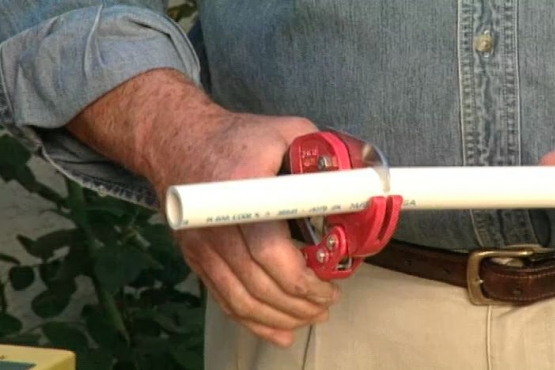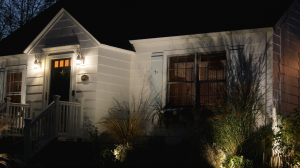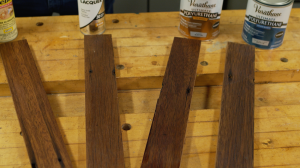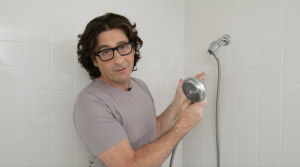RON HAZELTON:
Well summer's just around the corner, so I've been cleaning my air conditioning filters. And that got me to thinking that there were some times last season when the air conditioning seemed to be working okay but the air inside the house just wasn't all that comfortable. So I decided to call in an expert to check things out.
He should be here any minute. How you doing?
BILL:
Hi, I'm Bill Valance with Encom.
RON HAZELTON:
Hey Bill.
BILL:
Ron.
RON HAZELTON:
Come on in. Beautiful morning huh?
BILL:
Very nice.
RON HAZELTON:
Let me show you what's going on here. Okay Bill, well here's my air handler. Now you know on really hot days this works fine. The whole air conditioning system seems to be fine. But it's those days when it's not quite so hot, 70, 72 - the temperature's okay but the humidity - it feels really sticky in the house.
BILL:
Yeah. To be comfortable, you really have to control the humidity as well as the temperature.
RON HAZELTON:
And isn't that what an air conditioner does though?
BILL:
The air conditioning will do a good job with controlling the temperature. But not always the humidity on the days that you're talking about in the 70s. It's not running long enough to really drain the moisture out of the air.
RON HAZELTON:
So there's nothing wrong with my air conditioner then?
BILL:
Not necessarily.
RON HAZELTON:
So what do I do with this, just live with it?
BILL:
Well you can add a dehumidifier that will dehumidify the whole house on the days when the air conditioning is not running long enough to drain the moisture out.
RON HAZELTON:
The whole house dehumidifier Bill's suggesting will attach to my existing air conditioning system. A portion of the recirculated return air is diverted and drawn through the dehumififier where moisture is removed. This dry air then rejoins the main stream of air moving through the air conditioning system.
Lowering the overall humidity. I've decided to go ahead with the installation. So Bill sends one of his crews over and they go right to work. In their shop, they've fabricated a metal stand which they place in position. Despite its rather modest size, this unit will control humidity in the entire house. Bob and Joe set it on top of the stand. Next, a plastic hose is attached to carry away the water that will be extracted from the air.
The hose in turn is connected to a run of PVC pipe that will discharge the water into a basement drain. Several sections of sheet metal air duct have been pre made in the shop. These slip together and are held in place with screws.
Some duct work is made up on site from flat sections that are first cut to length - then rolled into a cylinder and snapped together. A crimper puts a series of indentation in one end that will effectively reduce the diameter so that one section of duct can be inserted into another.
The dehumidifier loop has to channel humid air from the air conditioning system and then return drier air to it. That means cutting into the existing air conditioning duct work. [MUSIC]
Now there's no question in my mind, sheet metal work is an art. But it's also important to have the right tools. For example the right snips. Now here are 3 pair that look the same but they have distinctly different purposes. This pair is intended for making straight cuts.
Right hand curves call for these snips. Handles are often green. And finally for cutting left curves, you'll want these. Their handles are sometimes red. The right and left curve cutting snips will also cut straight. Now the point is, when it comes to cutting sheet metal, not all snips are created equal.
The duct is inserted into the hole and held in place by bending the metal tabs on the inside. Some longer sections of duct work are supported with metal bands attached to the ceiling joints.
What a beautiful installation. You know this is like sculpture to me.
BILL:
Yeah. Bob and Joe did a great job. Came out -
RON HAZELTON:
Ah. Now I want to ask you a couple questions. You're saying that this unit will keep the humidity level in the entire house, including the basement at a comfortable level.
BILL:
That's right.
RON HAZELTON:
Okay. If I were instead to use portable units like the one I had here in the basement, how many would it take to do this house?
BILL:
At least 2 or 3.
RON HAZELTON:
And would it cost more or less to operate the 2 or 3 portable units than this one?
BILL:
It costs less to operate this, to remove the same amount of moisture as several portable units.
RON HAZELTON:
Also I know that if I use these, I've got to take the - the water out and empty these about once a day.
BILL:
That's right.
[BOTH SPEAK AT ONCE]
Right, this has an automatic drain.
RON HAZELTON:
So the water comes out here?
BILL:
That's correct. And goes into the drain of the basement, that's right.
RON HAZELTON:
What about sound? We haven't turned this on yet.
BILL:
These are very quiet.
RON HAZELTON:
Wow it's quiet. And we're standing right here next to it. I mean I'm not even gonna hear this at all in the rest of the house.
BILL:
That's right.
RON HAZELTON:
Do most people use these - I mean what -what's the call for these? I mean when people call you up, what are they looking for in terms of a solution?
BILL:
Sure, these are central dehumidifier that can be used for several different applications. The most common is for a finished basement where you don't need air conditioning to control the temperature because it stays cool in the basement. But you need to drain the moisture out of the air. So we can put this in an unfinished basement, or an unfinished portion of the basement or storage room and the air can be ducted in to dehumidify the finished basement.
RON HAZELTON:
Now two thirds of this basement over there is finished. You're saying that this will do just as good a job keeping the humidity level down here as the portable did?
BILL:
That's right.
RON HAZELTON:
And will - in addition to that, do the entire house.
BILL:
That's correct.
RON HAZELTON:
Thank you Bill. I really appreciate it. This has been very interesting and I can't wait for the hot humid weather to be here.
BILL:
Great.
RON HAZELTON:
And try this out.








